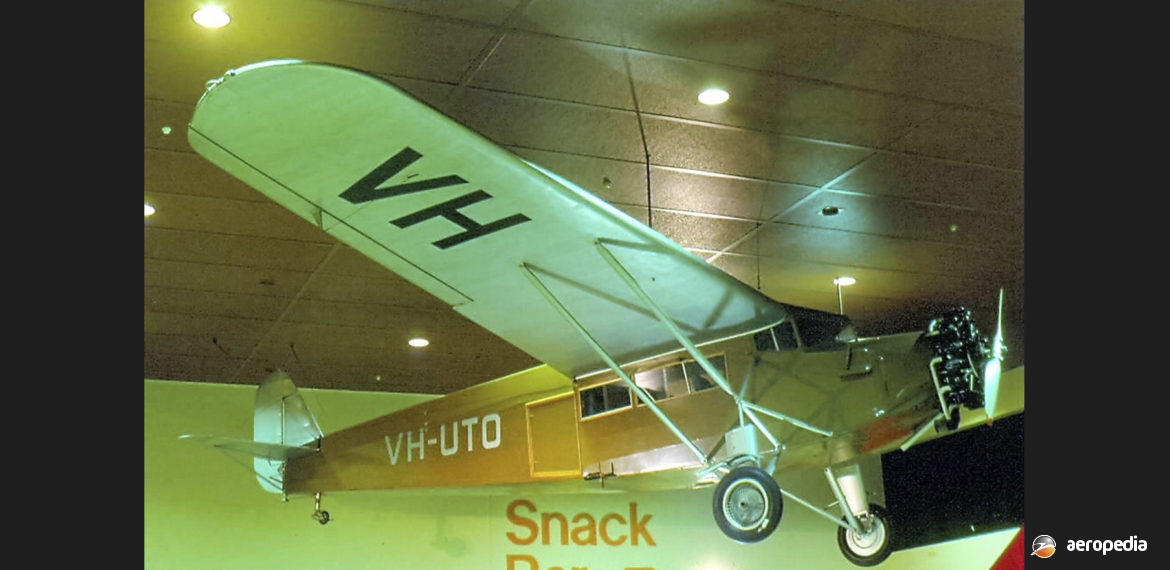Photograph:
Fokker F.XI Universal VH-UTO (c/n 5124) in the Ansett Airlines terminal at Mascot, NSW in October 1988 (David C Eyre)
Country of origin:
The Netherlands
Description:
Commercial airliner
Power Plant:
One 224 kw (300 hp) Wright Whirlwind J-6 nine-cylinder air-cooled radial engine
Specifications:
- Wingspan: 16.2 m (53 ft 9 in)
- Length: 11.1 m (36 ft 5 in)
- Height: 3.05 m (10 ft)
- Wing area: 35.5 m² (328.1 sq ft)
- Max speed: 175 km/h (109 mph)
- Cruising speed: 143 km/h (89 mph)
- Initial rate of climb: 213 m/min (700 ft/min)
- Ceiling: 4,400 m (14,435 ft)
- Range: 800 km (497 miles)
- Empty weight: 1,325 kg (2,921 lb)
- Loaded weight: 1,900 kg (4,189 lb)
History:
The Universal, built by the Fokker Aircraft Corporation in the Netherlands and the Atlantic Aircraft Corporation, based at Hasbrouck Heights and Teterboro, New Jersey, USA, was the first Fokker type designed entirely in the USA. The Model 4 Universal was designed by Robert Noorduyn, and appeared in 1925 powered by a 149 kw (200 hp) Wright J-4 radial engine. Construction was similar to other Fokker transports of the time.
In 1928 the Model 8 Super Universal was released. Known for a short time as the Universal Special, it had greater power, higher operating weights and performance, being able to carry six passengers. Eighty were built and modifications were made to the design during the production period including the elimination of the wing bracing struts, straight tapered wings with inset instead of overhung ailerons, and an altered undercarriage. The first production Super Universal was used by Admiral Richard E Byrd during his Antarctic Expedition in the 1930s, and others were exported to Argentina, Australia, Canada, Colombia, Mexico, South Africa, and the United Kingdom.
Fourteen were built in Canada under licence by Canadian Vickers, 29 were produced by Nakajima in Japan with 336 kw (450 hp) Jupiter engines, and three were built in 1929 by Fokker in The Netherlands, these being known as the F.XI Universal.
Three Universals have been seen in Australia over the years. The first, built in September 1927, was an Atlantic-Fokker Corporation Model 4 Universal (c/n 422). After carrying the registrations NC3199, G-EBUT, and VP-KAB, it was brought to Australia and became VH-UTO. Fitted with a 149 kw (200 hp) Wright J-5 Whirlwind engine, it was registered on 9 June 1935 to G H Purvis and R A Savage of Sydney, NSW. On 9 December that year it made a forced landing on a beach at South West Rocks, east of Kempsey, NSW. It is said it was operating with Western and Southern Provincial (WASP) Airlines at the time.
On 11 January 1936 registration was transferred to R M Ansett (founder of Ansett Airlines) of Hamilton, VIC and the Model 4 Universal was named ‘Miss Hamilton’. Ownership was transferred to Ansett Airways Pty Ltd in January 1936 but, after three years of service with that company, the aircraft was destroyed in a hangar fire at Essendon, VIC, on 28 February 1939.
As the Model 4 Universal VH-UTO was the first aircraft of Ansett Airlines, in 1973 the company purchased a Fokker F.XI Universal (c/n 5124) from Graz in Austria. Formerly registered CH188, HB-ALO, and OE-DAA, this aircraft was restored by Ansett engineers and, painted as VH-UTO, was displayed in Ansett terminals in Sydney and Melbourne, VIC at various times. It was eventually placed on display at the Ansett Museum at Hamilton, VIC.
A third Universal was imported, this being an American-built Atlantic-Fokker IV/F.XI which, after operating in the USA as NC8046, was brought to Australia in January 1929 as VH-UJT (c/n 436) for MacRobertson Miller Aviation Company Ltd, being fitted with a 164 kw (220 hp) Wright J-5 Whirlwind engine. In June 1934 it was fitted with a 224 kw (300 hp) Pratt & Whitney Wasp Junior engine and continued in service until 21 April 1939 when ownership was transferred to the Catholic Mission of the Holy Ghost at Alexishafen, PNG, being registered to that organisation on 24 May. However, it crashed at Alexishafen on 6 August 1939.

